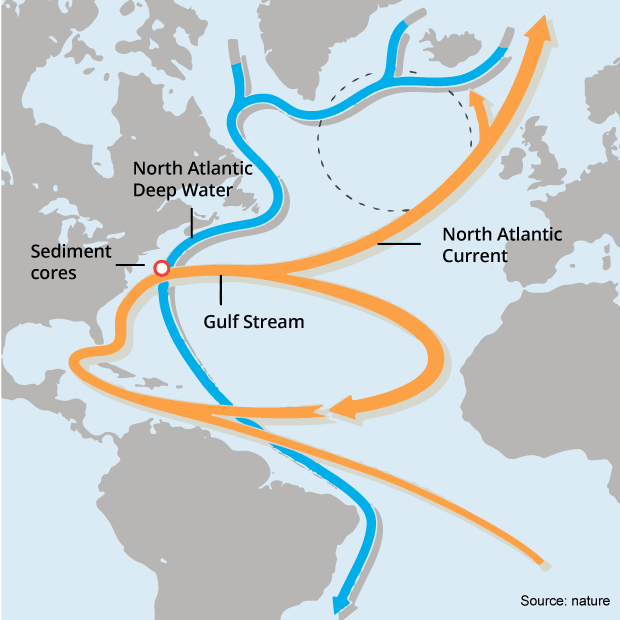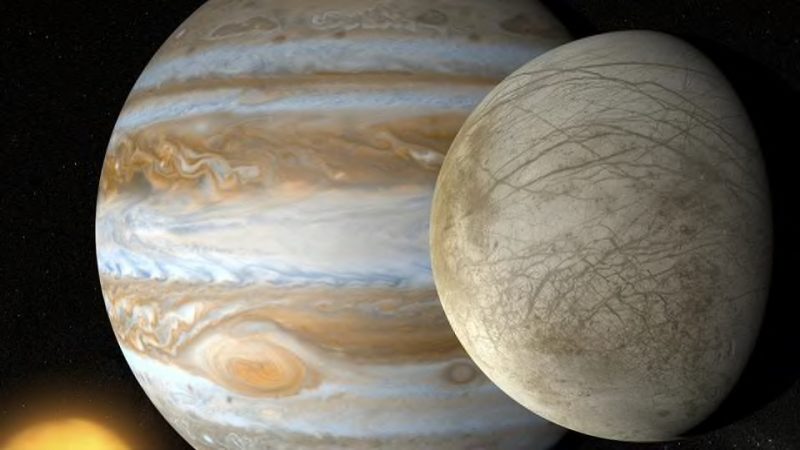
Like Earth, Jupiter’s moon Europa is believed to be a water world. Scientists have strong evidence that a global subsurface ocean lies beneath Europa’s outer icy surface crust. From what we know so far, this marine environment isn’t too different from what exists in Earth’s oceans. There’s a rocky bottom and possible hydrothermal vents much like those found on ocean floors on our planet.
Now researchers in Paris have found that there might be another common feature – ocean currents – and specifically what scientists are calling an oceanic jet stream for Europa. In a new peer-reviewed paper in Nature Astronomy – published March 11, 2019 – these scientists described evidence that Jupiter’s magnetic field might be creating a jet stream in Europa’s ocean, which may be comparable to the Gulf Stream on Earth.
Christophe Gissinger and Ludovic Petitdemange co-authored the new work. They are both based in Paris with École Normale Supérieure and the Laboratory for Studies of Radiation and Matter in Astrophysics. From their paper’s abstract:
During recent decades, data from space missions have provided strong evidence of deep liquid oceans underneath a thin outer icy crust on several moons of Jupiter, particularly Europa. But these observations have also raised many unanswered questions regarding the oceanic motions generated under the ice, or the mechanisms leading to the geological features observed on Europa.
By means of direct numerical simulations of Europa’s interior, we show here that Jupiter’s magnetic field generates a retrograde oceanic jet at the equator, which may influence the global dynamics of Europa’s ocean and contribute to the formation of some of its surface features by applying a unidirectional torque on Europa’s ice shell.

The researchers used data from the Galileo mission to Jupiter, which ended in 2003. They theorized that Jupiter’s powerful magnetic field might produce movement in Europa’s salty subsurface ocean, and their numerical simulations confirmed this idea. They said the jet stream in Europa’s ocean should be close to the moon’s equator, moving a few centimeters per second, and flowing in the opposite direction of the moon’s spin.
Such a jet stream could help explain why Europa’s surface is so cracked. The flow of the jet stream opposite the moon’s rotation would cause stress in the outer ice shell, forming the cracks. Gissinger told New Scientist:
It will not slow down the entire moon because the tidal forces from Jupiter are huge and will keep Europa’s rotation the same, but it will create these cracks that we have seen.

Another calculated effect would be thinner ice near the poles, since some of the energy from the magnetic field would dissipate off the moon’s surface, near the poles. And that is exactly what has been observed. Possible geysers have been seen on Europa’s surface, similar to ones found on Saturn’s moon Enceladus, which also has a global subsurface ocean.
What makes a jet stream even more interesting is that on Earth, the Gulf Stream helps to move around compounds that are needed for life. This may increase the chances of life existing in Europa’s ocean. As noted by Gissinger:
We know on Earth that the Gulf Stream is very important for transporting compounds which are important for life.
Europa’s ocean is thought to be quite similar to the deep ocean environment on Earth. It’s pictured as dark and salty, with hydrothermal vents on the ocean floor that could also serve as warm niches for life, just as they do on Earth. Life thrives around those kinds of vents in Earth’s oceans, which provide both heat and nutrients. Could the same be happening on Europa? Only further study of Europa will help to answer that question. To that end, space scientists are planning a new mission to this moon of Jupiter’s – Europa Clipper mission – to be launched sometime in the early 2020s.

Europa Clipper will conduct multiple close flybys of Europa, using advanced instruments to analyze the moon’s surface and the ocean itself in much more detail than ever before. A lander mission may also follow Europa Clipper later, which would actually touch down on the icy surface and examine the ice and regolith for possible evidence of life that may have been deposited on the surface by geysers or other upwelling from the ocean below.
Europa’s ocean and the subsurface oceans of other moons like Enceladus and Titan have shown that water worlds are actually common in our solar system – and perhaps in other solar systems as well. The new study shows that while Earth’s oceans may be on the surface of the planet, hidden oceans on other worlds can still share many of the same characteristics, making them exciting environments for exploration.

Bottom line: If there is a jet stream in Europa’s ocean, it would not only make that ocean even more similar to ones on Earth, but could even increase the chances of life in that deep, dark, alien abyss.
Source: A magnetically driven equatorial jet in Europa’s ocean











